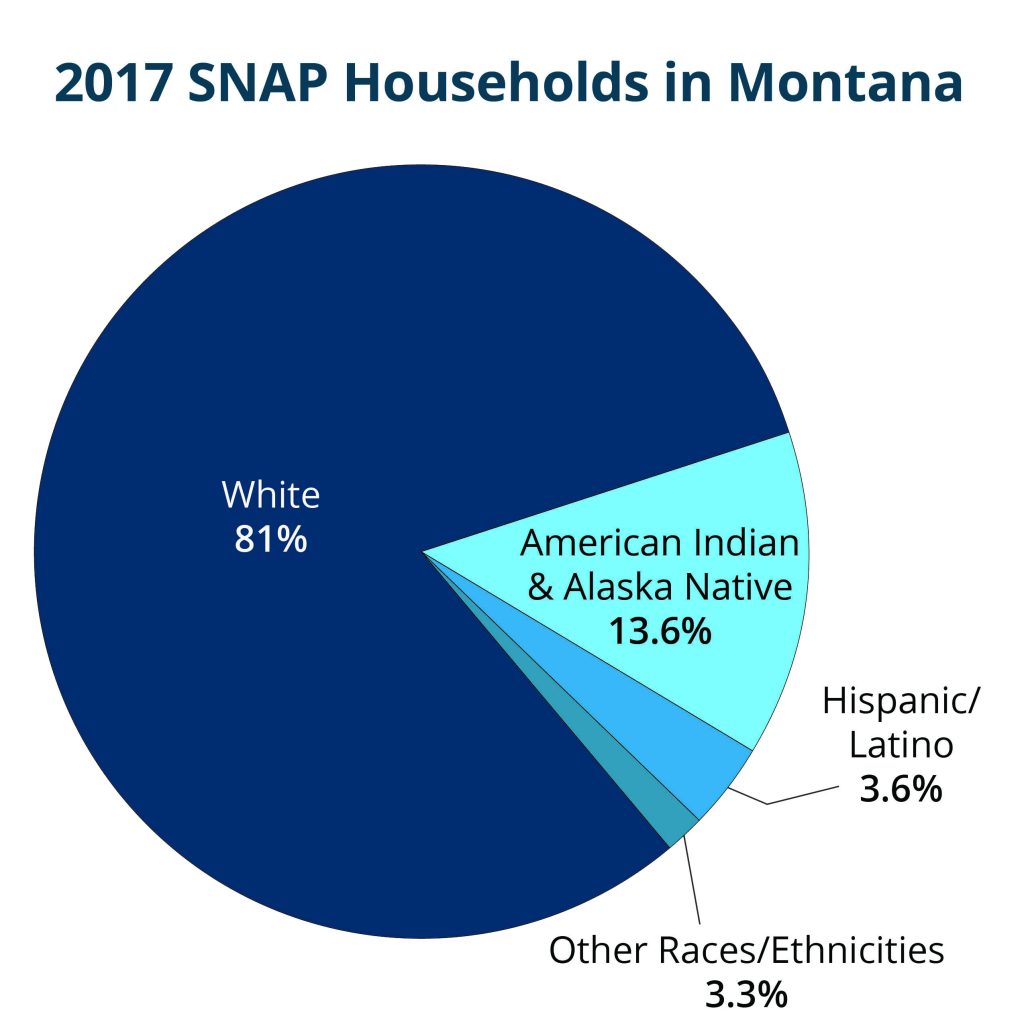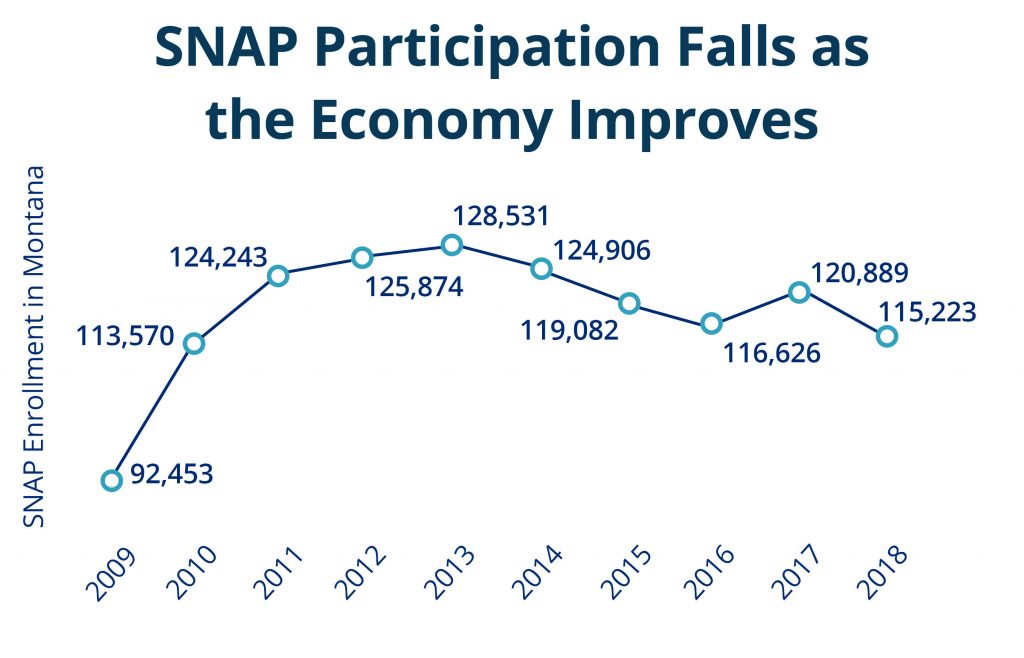All Montanans should be able to access the food and nutrition they need to live a healthy life, but tens of thousands of people across the state face food insecurity. SNAP, the Supplemental Nutrition Assistance Program, formerly known as the Food Stamp Program, is one of the nation’s most effective anti-poverty and anti-hunger programs in existence. Each year, the program provides critical food support for more than 100,000 Montanans.
The Food Stamp Program originally began in 1939 during the Great Depression and was formalized and expanded in the 1960s. In the 1980s, the program began to include job search assistance and work-related training. In 2008, the name of the program was changed to the Supplemental Nutrition Access Program (SNAP).[1] Throughout its history, SNAP has been one of the nation’s foremost programs to counter food insecurity and poverty. It is an effective and efficient program that has improved the lives of millions of Americans.
Today, SNAP provides basic food assistance for individuals and households, whose eligibility is based on income and existing assets, such as a savings account. Assistance is provided monthly, typically through an Electronic Benefits Transfer (EBT) card and can be used to purchase certain food products at eligible stores. SNAP benefits are federally funded, with states and the federal government splitting the administrative costs.
SNAP eligibility is tied to annual income and determined at the household level. All household members considered for eligibility must be U.S. citizens or legal aliens and must provide or apply for a social security number. People who live together and buy and prepare food together are considered a household. For example, spouses and children under age 22 living with their natural, adoptive, or step-parents must be considered one household.[2]
Expanded Categorical Eligibility (ECE – also known as Broad Based Categorical Eligibility) is a policy allowing states to slightly raise the income and impose less restrictive asset tests for those seeking food assistance. ECE helps households with high expenses and prevents a benefit cliff if income is increased.
Some households are eligible for expedited services, which makes food benefits available within seven calendar days of the application date. Eligible households include:
For households with a member over age 60, or a member with a disability, resources cannot exceed $3,500 ($2,250 for other households), unless the household qualifies under ECE. Homes, vehicles, tax-preferred educational and retirement accounts, and combat-related military pay do not count as resources.[4]

Some individuals on SNAP must meet certain work requirements. Those age 16-59 must work 30 hours a week, unless they are caring for an individual under age 6, are participating in drug or alcohol treatment program, or are in school or a training program at least half-time.[5] If participants fail to meet these work requirements, they are disqualified for receiving SNAP for one month. If participants fail to meet work requirements again, they are potentially disqualified for receiving SNAP permanently.[6]
In order to help individuals meet the work requirements, Food and Nutrition Services (FNS) provides funding annually to states to operate SNAP Employment and Training (E&T) Programs.[7] The SNAP E&T program assists able-bodied adults without dependents (ABAWDs) with education, training, and employment-related support services. In Montana, however, the SNAP E&T program, funded by a grant with the U.S. Department of Agriculture (USDA) and FNS is only available in Yellowstone, Missoula, and Lewis & Clark counties.[8]
Individuals who are ABAWDs and are age 18-49 are limited to receiving SNAP for three months out of a three-year period unless they are working or in a work-training program for at least 20 hours per week.[9] States may apply for ABAWD work requirement waivers for areas with high unemployment or low job availabilities.
Benefits are determined through a formula that considers net income and how much households will need to spend on food. On average, SNAP benefits provide $115 in food assistance a month in Montana.[10] The graphic below explains how benefits are calculated.

Households are expected to contribute 30 percent of their net income after deductions to their food budget. The maximum monthly benefit is determined by the USDA’s Thrifty Food Plan, which calculates how much households would have to spend to receive adequate nutrition at minimal cost.[11]
Net income is determined by subtracting certain deductions from a household’s gross income. These deductions include:
Food insecurity in Montana is below the national average. More than 10 percent of households in the state experience food insecurity, and 3.9 percent experience very low insecurity.[13] Limited access to grocery stores and supermarkets plays a role, as well. In counties with significant American Indian populations, nearly 33 percent of people have low access.[14] Due to barriers to accessing both food and employment, food insecurity on reservations is higher, with some areas facing up to 43 percent food insecurity.[15]
In April of 2020, 108,458 people in 54,374 households participated in SNAP in Montana.[16] The majority of participants are white; however, American Indians are overrepresented due to systemic economic disempowerment.
Colonialism dismantled the food systems of tribal nations and suppressed economic opportunities for American Indians.[17] Depressed economies create few job opportunities and result in high unemployment.[18],[19] These external causes result in high food insecurity rates among American Indian households. American Indians represent 4 percent of all Montana households[20] but comprise 13 percent of those households receiving SNAP benefits. One in three American Indian households participate in the program, compared to one in ten of Montana households overall.[21],[22]
The seven highest SNAP participation rates in the state can be found in counties with reservations within their borders. These reservations also experience high unemployment rates.[23] Glacier County, where the Blackfeet Indian Reservation is, for example, sees the highest SNAP participation rate in the state at 34.66 percent. Big Horn County, where much of the Crow and Northern Cheyenne Indian Reservations reside, follows with a rate of 33.49 percent.[24]

Consistent with the national average, an estimated 87 percent of people who are eligible for SNAP in Montana participate in the program. Among people who are eligible for SNAP and live in a household where someone earns wages, participation is slightly lower – 82 percent.[25] Participation for eligible seniors statewide is significantly lower than the national average. Only 33 percent of eligible seniors participate in SNAP, compared to 42 percent nationwide.[26]
Most working-age SNAP recipients who are able to work have jobs, but those jobs are often unstable and low-paying.[27] In Montana, one worker was present in 43.9 percent of households, and 37.3 percent of households had two or more workers present.[28] Only 18.8 percent of SNAP households did not have anyone who worked in the last 12 months. SNAP recipients can experience temporary joblessness, and SNAP serves as an important short-term support. SNAP recipients are more likely to receive SNAP when they are not working than when they are.[29]
SNAP helps families below or near poverty level, with the vast majority of the benefits going to help those below the poverty level. About 92 percent of SNAP benefits go to the 55 percent of people living below the poverty level.[30],[31] The median income of SNAP households in Montana was $19,728. [32] SNAP also disproportionately serves households with children and people with disabilities. Households headed by single mothers have the highest rates of food insecurity.[33]
SNAP has been one of the most effective ways of reducing food insecurity, but benefits are still often inadequate to feed an entire household. Half of SNAP recipients are still food insecure. SNAP benefits are about $11 short per person per week of the purchase cost of a nutritious meal plan.[34] The average SNAP benefit per recipient in Montana is $115 a month, 12 dollars less than the national average.[35]
The benefits of SNAP extend past increased access to healthy food. In 2016, SNAP lifted 7.2 million people, including 3.3 million children, out of poverty.[36] Children who receive SNAP benefits have better health and perform better in school.[37]
Participation in SNAP also improves outcomes for adults. Access to SNAP may lower health-care costs, with one study finding adults on SNAP incur $1,400 less in medical care costs than non-participants living on low incomes. They also take fewer sick days and are less likely to forego medical care because they cannot afford it.[38]
SNAP is an important part of Montana’s economy. Nationwide, SNAP accounts for 10 percent of the food that people purchase. Not only does SNAP increase food purchases, it frees up funds for households to purchase other important goods like medicine.[39] For every dollar spent in SNAP funding, $1.80 is generated in economic activity.[40] For every one billion spent in SNAP funding, 13,560 jobs, including 500 agricultural jobs, are created.[41]
Local retailers also benefit from SNAP. In Montana, 763 retailers accept SNAP benefits.[42] The majority of benefits are redeemed at large superstores and grocery stores; however, 20 percent of benefits go to smaller stores. Participating retailers must meet certain requirements, such as providing access to a variety of goods including perishable foods or receiving 50 percent of retail sales from staple goods. [43]
During a recession, SNAP is an essential form of economic stimulus. During recessions and periods of high unemployment, more people rely on SNAP to meet basic needs. In turn, SNAP benefits help stimulate the economy. SNAP caseloads decrease as the economy improves, typically lagging 2.5 – 3 years after the unemployment rate falls.[44] Montana’s caseload rose sharply during the Great Recession but has fallen since its high of 128,531 participants in 2013.[45]

SNAP plays an essential role in helping individuals and families access the food they need to maintain healthy lives. Because of the program’s importance in not only reducing food insecurity, but also its ability to improve the economy and lift individuals out of poverty, SNAP should be protected and strengthened. In our land of agricultural bounty, no Montanan should worry about where their next meal comes from.

MBPC is a nonprofit organization focused on providing credible and timely research and analysis on budget, tax, and economic issues that impact low- and moderate-income Montana families.